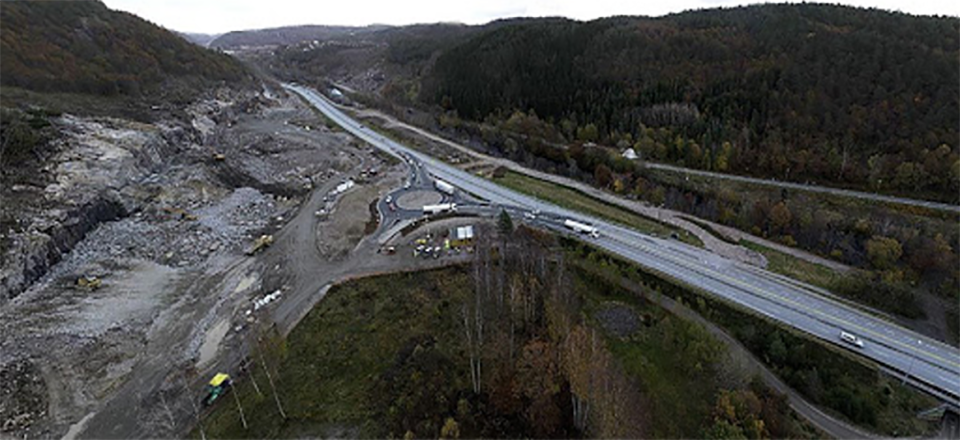
AF Anlegg’s Head of Machine Control and Automation talks about managing mixed fleet dataflow on project E39 motorway
AF Anlegg is a leading constructing and industrial group. In 2018 they signed a contract with Nye Veier for the engineering and construction of the new E39 motorway. E39 Kristiansand West – Mandal East was the first contract in Nye Veier’s E39 portfolio to be put in production. With a framework of NOK 4.7 billion, the contract at the time of signature was Norway’s largest turnkey road construction contract.
The project comprises of a new 19 kilometer four-lane motorway with a 110 km/h speed limit from Kristiansand west to Mandal east. Work includes several tunnels and bridges, including the 4 km Søgne tunnel and the 520 m Trysfjord bridge. AF Anlegg has Norconsult as a consultant and Kruse Smith Entreprenør as a subcontractor. Construction began in November 2018 with completion scheduled in October 2022.
All production data has been made available to field workers through Infrakit and its FIELD application.
This development project will remedy the road’s current shortcomings, which include poor traffic safety and low speed limits. Heavy traffic in particular has accessibility issues during wintertime and by building a new E39, passability and safety will improve significantly.
All earthworks are being handled via Infrakit. AF Anlegg is using Infrakit to connect all the machines and organize their production models for model-based earthworks. Infrakit collects intelligent documentation which gives progress and quality data in real time.
We interviewed Kristen Petillon the Head of Machine Control and Automation from AF Anlegg about his work on the project with Infrakit.
Background information on Kristen and project goals
Kristen Petillon has previous experience as a heavy equipment superintendent and has been responsible for maintenance of machines. He began his work with AF Anlegg in 2018 and is responsible for two main areas within the company: innovation technologies around autonomous (driverless) machines and machine control.
His team consists of three people, one technical superintendent and two technicians on the field. Besides being in charge of his team he is also in charge of the dataflow at the projects.
“In terms of dataflow, one of the main goals we’ve had is to try and maximize the automation regarding distribution of files to the machine from the models and back to our geo-controlling software.”
“When I started in AF, one of our major earthmoving projects in Norway between Arendal and Mandal used many different equipment brands, suppliers and sub-contractors which all had their own machine control system. At one point we probably had all the brands available on the market, some of these having their own proprietary file format which is an extra pain to manage. During that period, we had to use five different workflows to bring data to the machines and five to get the as built data back.”
“So, what we did was develop with a consultant an RPA software (Robotic Process Automation) that will emulate the human movement of clicks and moving of files. It was an okay solution for the time being, but due to it not being completely integrated (we sometimes had to use the webpages provided by some suppliers) if there were any changes on the client side we had to, at worst, start the development all over again.”
During that time Anders Tiltnes Sales Director Infrakit AS got in contact with Kristen and introduced Infrakit’s solution.
How did Infrakit benefit the dataflow and cooperation of the project?
“Just the fact that we can have a structured way to manage all files in just one place, that data can be automatically and reliably sent to the machines while having good control over which machine has which information for both models and as built data is the main benefit for us.”
“The beginning was slightly slow due to integrations having to be setup but since then I think Infrakit has been a big help, mostly for the fact that I can use just one tool to manage the whole dataflow. At the beginning we also used Infrakit a little for checklists and picture documentation.”
How would the project have been different without Infrakit? How would your work be different without it?
“We would have had to require some people to spend a lot of time manually checking that data was correctly distributed to machines and have as built data imported back to our tools with our old RPA solution. Especially for Geo surveyors, I think they would have wasted a lot of time on checking data quality.”
What kind of other use cases did you have with using Infrakit during the project?
“There were some instances of people using Infrakit to know where they were while putting up fences and at the beginning some guys were bolting and drilling holes to reinforce mountain sides and used Infrakit to document or take pictures. But this was also something that we sort of expected in the beginning but more as a support function.”
What would you tell someone who’s thinking about getting Infrakit?
“I do see a value in using Infrakit for managing machine dataflow. I have already told some people who were thinking about investing into Infrakit, that the transfer of data between the machines and Gemini has been very effective, worked well and we are very satisfied, and I would definitely recommend it for that purpose.”
Book a Demo
Discover how Infrakit connects your entire infra project operations and drives value to every part of your business.
